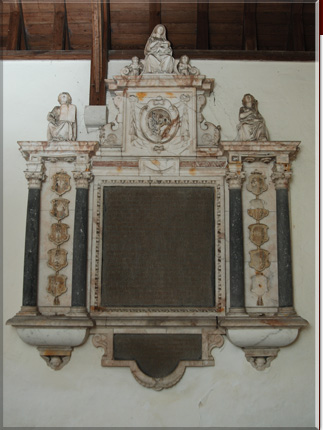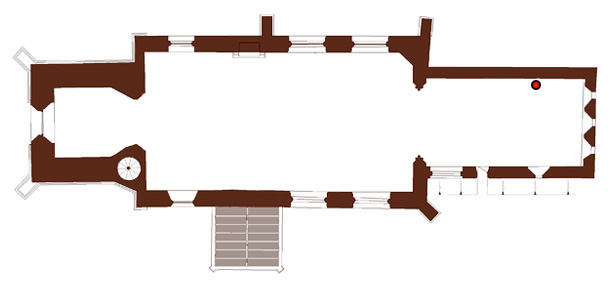To see what the numbers 1-10 of each memorial description are click here
- This imposing monument, which reaches up almost to the roof of the chancel, is made of pink-veined alabaster and various marbles, which form an architectural surround to a very large inscription tablet flanked by mounted heraldic shields. The monument is surmounted by a stepped and moulded cornice upon which is the allegorical female figure of Charity, here seated nursing a baby, with two other naked children sitting at each side of her feet. Below this is a large square panel with heavy volute scrolled wing brackets, enclosing a carved oval cartouche set against a swagged cloth, and containing the family arms with considerable traces of the painted tinctures remaining.
Blazon (Argent) on a pale (Sable) three crosses pattée (Or) a bordure engrailed of the second [CROWCH] (ref a, also see 7)
impaling
(Argent) on a chevron (Sable) three headpieces [SCOT] (ref a, also see 7)
On either side of the panel, on the projecting cornices, are two other seated allegorical female figures. On the west is Faith: a draped figure holding the tablets of the Ten Commandments which rest on the left knee. On the east is Hope: a similar figure but holding an anchor on her lap and left shoulder. The flukes at the top are missing. The whole rests upon a classical entablature supported by pairs of free-standing Corinthian columns. The soffits of the projecting cornices each bear a pair of pendant flowerheads. The column shafts are of grey fossiliferous marble, with the capitals and bases white. Through each pair of columns are seen the heraldic shields showing the alliances of the Crowch children with the sons on the west and the daughters on the east. There are ten carved and painted shields, five on each side, mounted one above the other as if hanging from a tasselled ribbon. Blazons are given from top to bottom. Christian names taken from the inscriptions have been added.
West side:
Blazon 1 CROWCH (John) impaling Gyronny of eight Or and Azure on a chief Sable three annulets Argent [ROLFE] (ref a)
Blazon 2 CROWCH (Thomas) impaling Azure a bend between three roses Or [GALLIARD?] (ref b)
Blazon 3 CROWCH (Richard)
Blazon 4 CROWCH (Nicholas)
Blazon 5 CROWCH (William) impaling Gules a fess dancetté between ten billets Or [BRETT] (ref a)
East side:
Blazon 1 Azure three lozenges Argent differenced with a crescent [FREMAN William] impaling CROWCH (Elizabeth) (ref a)
Blazon 2 Argent three pales Gules over all a chevron Or [BARKHAM Edward] impaling CROWCH (Jane) (ref a)
Blazon 3 Argent three fusils conjoined in fess Gules a bordure Sable [MONTAGU Edward] impaling CROWCH (Ann) (ref a)
Blazon 4 Azure three lozenges Argent differenced with a martlet [FREMAN Ralph] impaling CROWCH (Joan)
Blazon 5 Argent three fusils conjoined in fess Gules differenced with a crescent [MONTAGU Henry] impaling CROWCH
(Margaret) (ref a)
Some tinctures still remain on them all, in patches, but on shield 3 on the east side this wear makes it look as if wrongly painted, with the fusil appearing white (argent) and the ground red (gules), the reverse of what is correct. All the above rests on an ovolo shelf supported by large curved brackets over stepped mouldings and winged cherub heads. The apron between the brackets is a pendant inscription tablet set within a decorated white border with a nowy bottom and small scrolled wing brackets. The Latin inscriptions are incised on dark grey marble in roman-style caps throughout, some larger, and are gilt-filled. Obscure letters are bracketed at 9. The word Londiniensis has been mis-spelt throughout (it is minumthe second ‘i’). The word moretar should read: moretur meaning delayed. On the eighth line the word salvr: is an abbreviation for saluorum. The last line may be translated as ‘Lord Privy Seal’. The main inscription tablet has an egg and dart frame. There are a few distortion gaps in the structure. Part of shield 2 on the west side and half of shield 2 on the east side are missing. Shield 5 on the east side, which also has a part missing, has become detached but is kept elsewhere in the church.
- Alabaster, marble
- 1634 (see at 7)
- Estimated h. 400 x w. 284 x d. 33.5cm Inscription tablet: h. 158cm
- -
- -
- A photograph in the Gerish Collection (early 20th c) at Hertfordshire Archives, County Hall,
Hertford shows the flukes of the anchor held by Hope.
Burke’s The General Armory gives these Crowch arms with the addition of a crest, as being
granted in London in 1608, three years after the
death of John Crowch. The headpieces (helms) on
the arms for Scot(t) have been wrongly interpreted
by the historians: Cussans, who suggested that they
were Catherine wheels, and Clutterbuck, who
thought they were roses.
John Crowch the elder was a citizen and
clothworker of London. He bought the manor of
Corneybury from Thomas Howard late in the 16th
century and is listed as patron of the church in 1588.
The manor , along with the church advowson, stayed
in the family until sold in 1690 by Thomas Crouch,
fourth in line of descent from John. (ref c)
Ralph Freman resided at Aspenden Hall during the
1630s (ref d).
Margaret Crowch was the third wife of Henry
Montagu, 1st earl of Manchester and he was her
third husband (ref e)
The setting up of the monument was delayed, as
mentioned [moretur] at the top of the main inscription, but a date can be narrowed down, at
least for its commissioning, by investigation of references to the offices held and the deaths
of some of those mentioned in the inscriptions. Henry Earl of Manchester (dead at the time
of the erection of the monument) was appointed to his office of Lord Privy Seal in 1628.
Ralph Freman died in office as Lord Mayor of London in 1633/4 and was predeceased by
his wife Joan. (ref e) Edward Barkman died shortly after Ralph in 1633/4 (ref f). As
Barkham is not referred to as dead in the inscription, this dates the commissioning of the
monument at sometime early in 1634. By the time it was erected, however, the eldest
daughter, Elizabeth, was also dead, as mentioned in the lower inscription. The death dates of
the Crowch sons are not known, but it could be conjectured that the two unmarried ones may
have died young. However, it would appear from the lower inscription that all were dead by
the time the memorial was dedicated.
- Lady Margaret Countess of Manchester, Lady Jane Barkham, Lady Ann Montagu
- QVISQVIS ES, QVEM AD ÆDES HAS PIETAS IMPVLIT SISTES / PAVLVLVM TE,
HOC QUOD VIDES, MORETA(R) (sic) MONVMENTVM, / SACRVM MEMORIÆ
IOANNIS CROWCH DE CORNEYBERRIE, / ARMIGERI, LONDINI OLIM HVIVS,
DEIN COMITATUS. HAVD / EXIGVA DECORIS QVI POSTQVAM OCTOGESIMVM
SEXTUM ÆTATIS / SVÆ ANNVM SVPERASSET MENSE FEBRVARIJ, / ANNOQ3 A
NATO DNO: M.D.C.V NATVRAE DEBITUM REDDIDIT, / NON MINVS BONORVM
OPERVM QVAM, DIERVM SALVR: NATVS / ERAT BARVICI, IN PAROCHIA
STANDONENSI. IN VXOREM / CEPIT IOANNAM FILIAM ET HÆREDEM
IOHANNIS SCOTT / LONDINENSIS (sic), EX QVA FILIOS SVSCEPIT QVINQVE
IOANNEM, THOMAM, RICHARDVM, NICOLAVM, GVLIELMVM, / FILIAS ITIDEM
QVINQVE, ELIZABETHAM, GVLIELMI / FREMANNI, MERCATORIS LONDINENSIS
(sic), NVPER VIDVAM, / IANAM, EDVARDI BARCKHAMI, EQVITIS AVRATI ET /
LONDINENSIS (sic) OLIM CIVITATIS, PRÆTORIS CONSORTEM./ ANNAM,
EDVARDI, DOMINI MONTACVTI, / BARONIS DE BOVGHTON: IOANNAM NVPTAM RADVLPHO/ FREMANNO, GULIELMI FRATRI QVI NVPER PRÆTOR
EIVSDEM / LONDINENSIS (sic) CIVITATIS CREATVS DE VITA / PRIVS EXIJT
QVAM OFFICIO, ANIMAM CITIVS DEPOSVIT / QVAM MAGISTRATVM.
MARGARETTAM, VXOREM HOC / IPSO TEMPORE HENRICI, COMITIS, /
MANCESTRIÆ, PRIVATI / SIGILLI CVSTODIS. /
Translation: Whoever you may be, whom piety has driven to this building, pause for a little while at the delayed memorial which you see here. It is sacred to the memory of John Crowch Esquire, once of London and then of this county, a man of no small distinction. After completing the 86th year of his life, he paid his debt to nature in the month of Febuary, 1605, having accomplished as many good works as the days of his life. Born in Barwick, in the parish of Standon, he took to wife Joan, the daughter and heir of John Scott, and by her he had five sons: John, Thomas, Nicholas and William, and likewise five daughters: Elizabeth, who married William Freman, a London merchant, and who has recently become his widow; Jane, the wife of Sir Edward Barkham, former Lord Mayor of London; Ann, betrothed to Edward, Lord Montagu, Baron of Boughton; Joan, wife of Ralph Freman, brother of William, who, having just been appointed as Lord Mayor of this same city of London, died while still in office, giving up his life more speedily than his duties; and Margaret, who is still married to Henry, Earl of Manchester and keeper of the Privy Seal.
The dedicatory inscription on the apron below the main tablet :
MONVMENTVM HOC DOMINA MARGARETTA / MANCESTRIÆ COMITIS COMITISSA, DOMINA ANNA / MONTACVUTA ET DOMINA IANA BARCKHAMI / SOLÆ DE TAM NVMEROSA PROLE / SVPERSTITES OBSERVANTIÆ / ET AMORIS ERGO / POSVERVNT. /
Translation: This monument, Lady Margaret, Countess and wife of the Earl of Manchester and Lady Ann Montagu and Lady Jane Barkham, the only survivors of such a numerous family inscribed above, placed in respect and love.
- a) Burke pp 248 Crowch, 904 Scott, 867 Rolfe, 120 Brett, 377 Freman, 49 Barkham, 696 Montagu b) Papworth p 216 c) Cussans pp 81,87 d) VCH Vol 4 p 81 e) Oxford Dictionary of National Biography (on-line article by Brian Quintrell re Henry Montagu) f) VCH Vol 5 pp 330-333


